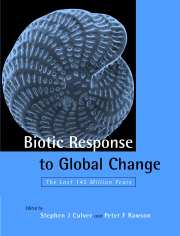Book contents
- Frontmatter
- Contents
- List of contributors
- Preface
- 1 Introduction
- 2 The Cretaceous world
- 3 The Cenozoic world
- 4 Calcareous nannoplankton and global climate change
- 5 Phenotypic response of foraminifera to episodes of global environmental change
- 6 The response of planktonic foraminifera to the Late Pliocene intensification of Northern Hemisphere glaciation
- 7 The response of Cretaceous cephalopods to global change
- 8 Global change and the fossil fish record: the relevance of systematics
- 9 Response of shallow water foraminiferal palaeocommunities to global and regional environmental change
- 10 Intrinsic and extrinsic controls on the diversification of the Bivalvia
- 11 Global events and biotic interaction as controls on the evolution of gastropods
- 12 Algal symbiosis, and the collapse and recovery of reef communities: Lazarus corals across the K–T boundary
- 13 Changes in the diversity, taxic composition and life-history patterns of echinoids over the past 145 million years
- 14 Origin of the modern bryozoan fauna
- 15 Angiosperm diversification and Cretaceous environmental change
- 16 Cenozoic evolution of modern plant communities and vegetation
- 17 Leaf physiognomy and climate change
- 18 Biotic response to Late Quaternary global change – the pollen record: a case study from the Upper Thames Valley, England
- 19 The Cretaceous and Cenozoic record of insects (Hexapoda) with regard to global change
- 20 The palaeoclimatological significance of Late Cenozoic Coleoptera: familiar species in very unfamiliar circumstances
- 21 Amphibians, reptiles and birds: a biogeographical review
- 22 Paleogene mammals: crises and ecological change
- 23 Response of Old World terrestrial vertebrate biotas to Neogene climate change
- 24 Mammalian response to global change in the later Quaternary of the British Isles
- 25 Human evolution: how an African primate became global
- 26 The biotic response to global change: a summary
- References
- Index
8 - Global change and the fossil fish record: the relevance of systematics
Published online by Cambridge University Press: 14 August 2009
- Frontmatter
- Contents
- List of contributors
- Preface
- 1 Introduction
- 2 The Cretaceous world
- 3 The Cenozoic world
- 4 Calcareous nannoplankton and global climate change
- 5 Phenotypic response of foraminifera to episodes of global environmental change
- 6 The response of planktonic foraminifera to the Late Pliocene intensification of Northern Hemisphere glaciation
- 7 The response of Cretaceous cephalopods to global change
- 8 Global change and the fossil fish record: the relevance of systematics
- 9 Response of shallow water foraminiferal palaeocommunities to global and regional environmental change
- 10 Intrinsic and extrinsic controls on the diversification of the Bivalvia
- 11 Global events and biotic interaction as controls on the evolution of gastropods
- 12 Algal symbiosis, and the collapse and recovery of reef communities: Lazarus corals across the K–T boundary
- 13 Changes in the diversity, taxic composition and life-history patterns of echinoids over the past 145 million years
- 14 Origin of the modern bryozoan fauna
- 15 Angiosperm diversification and Cretaceous environmental change
- 16 Cenozoic evolution of modern plant communities and vegetation
- 17 Leaf physiognomy and climate change
- 18 Biotic response to Late Quaternary global change – the pollen record: a case study from the Upper Thames Valley, England
- 19 The Cretaceous and Cenozoic record of insects (Hexapoda) with regard to global change
- 20 The palaeoclimatological significance of Late Cenozoic Coleoptera: familiar species in very unfamiliar circumstances
- 21 Amphibians, reptiles and birds: a biogeographical review
- 22 Paleogene mammals: crises and ecological change
- 23 Response of Old World terrestrial vertebrate biotas to Neogene climate change
- 24 Mammalian response to global change in the later Quaternary of the British Isles
- 25 Human evolution: how an African primate became global
- 26 The biotic response to global change: a summary
- References
- Index
Summary
INTRODUCTION
The modern fish fauna is dominated by two very different kinds of fishes, the neoselachians (sharks, skates and rays) and teleosts (e.g. herring, salmon, cod and perches). Both of these major groups originated before the Cretaceous but the age of differentiation (Hennig, 1966) of teleosts is approximately coincident with the temporal limit of this volume – the Late Jurassic/Early Cretaceous – and that of neoselachians is Early Jurassic. The last 145 million years have seen the diversification of neoselachians, resulting in a modern tally of 815 species contained in 164 genera and 42 families. In the same timespan teleosts have shown more impressive diversification to 23 637 species within 4061 genera and 426 families (counts taken from Nelson, 1994). Other, minor groups of fishes inhabiting the modern world include the jawless hagfishes and lampreys (73 species), ratfishes or chimaeriforms (30 species), polypteriforms or bichirs (11 species), lepisosteiforms or garpikes (7 species), amiiforms or bowfins (1 species), the coelacanth and the lungfishes (6 species). Together these make up less than 0.5% of Recent species diversity.
The brief given to contributing authors of this volume includes an invitation to outline the geological history of individual groups with reference to global changes which have taken place. This is rather daunting as it is all too easy to slip into scenario building, assuming cause and effect with little substantive evidence. Such evidence includes an assessment of the nature of the fossil record.
- Type
- Chapter
- Information
- Biotic Response to Global ChangeThe Last 145 Million Years, pp. 107 - 121Publisher: Cambridge University PressPrint publication year: 2000
- 1
- Cited by

